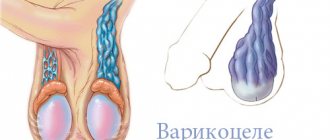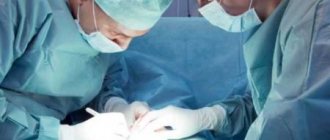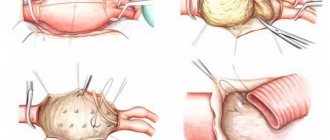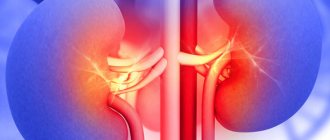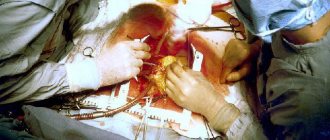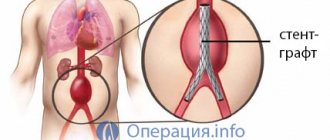Why does the disease return?
Repeated varicocele on the left side appears especially often in adolescents. This is explained by venous insufficiency and congenital pathologies of the venous valves.
Also, the most common reasons include:
- Disturbances in the functioning of the circulatory system. This includes problems with the cardiovascular system, weak veins, and impaired venous drainage in other parts of the body.
- Incorrectly chosen treatment method. For example, during a routine operation it is not always possible to identify and alloy the necessary veins, so additional trunks may be ignored. In this case, blood flow remains impaired. Sometimes, during an operation using the Ivanissevich method, the doctor may mistakenly ligate the wrong vessels. Instead, there may be veins of fatty or muscle tissue. After such surgical intervention, varicocele cannot be called a relapse, since no action was taken on the testicular vein.
- Various complications. Sometimes they do not make it possible to completely remove the dilated vessels of the scrotum. In this case, there is a need to repeat the operation.
The cause of relapse after laparoscopy is the detachment of the clip or incomplete clamping of the vein.
In rare cases, problems after surgery arise due to the fact that the doctor strives to make a minimal incision based on the aesthetic component. This may be affected by technical problems.
Causes of relapse and risk factors
Recurrence of varicocele is the persistence or resumption of venous reflux. That is, the blood returns to the vein and stagnates in it instead of flowing normally.
Reflux is indicated by a red arrow
Causes of relapse after surgery:
- Incomplete cessation of blood flow. The lumen of the vein is only partially compressed, blood continues to leak.
- Development of new bypass vessels (collaterals). The process takes from several months to 2 years.
- The wrong vein was ligated. Instead of the testicular vein, there is a hypogastric or fatty tissue vein, or not all branches (the testicular vein has several of them). This often happens during Ivanissevich's operation. Satellite veins often go unnoticed.
- Migration of material (embolic agent) used to block the lumen of the vein after endovascular intervention.
- Deformation or separation of the clip compressing the vein, incomplete compression after laparoscopic surgery. Such problems do not arise if the vein is cut after clamping with a clip.
- During microsurgical interventions, the cause of recurrent varicocele is improper identification of additional small veins. The Marmara operation is performed through an incision in the subinguinal region, and there the structure of the spermatic cord in the venous plexus is much more complex than in the inguinal region. There are many internal arteries that are surrounded by dense venous networks. In order not to damage them and not to disrupt the blood flow in the testicle, the surgeon must have extensive experience.
90% of relapses in adults are caused by technical errors during surgery. Some surgeons are too keen on the aesthetic side to the detriment of the result.
The likelihood of developing a recurrence of varicocele depends on the characteristics of the patient himself:
- Weak vascular walls, insufficiency of venous valves.
- Hereditary predisposition to the development of varicose veins.
- Venous congestion in the pelvic area (congestion) due to a sedentary lifestyle.
Often, relapse of varicocele occurs in men with May-Turner syndrome - compression of the common iliac vein. The pathology is accompanied by chronic pelvic pain, unstable erection, pain in the testicle and left leg.
May–Turner syndrome or compression syndrome of the left common iliac vein is the result of compression of a vessel by the right common iliac artery, which results in a violation of the outflow of blood from the left lower limb and pelvis
Prevention
Doctors have not yet determined the exact reasons for the recurrence of the pathology, so it is difficult to talk about effective means of prevention. When varicocele in men is associated with genetic abnormalities, the likelihood of recurrence of the disease is quite high. Recurrence of the disease can be prevented by thoroughly examining the patient before the initial operation and carefully selecting the optimal treatment.
A full examination will eliminate the possibility of leaving the affected vessel unblocked. The patient must also take into account the requirements of the surgeon in the postoperative period, namely, to give up nicotine addiction and alcohol. At an early stage after surgery, serious physical activity is contraindicated
It is extremely important to visit the surgeon as planned, and when the first signs of the disease appear. Compliance with the rules described by the doctor will ensure rapid recovery and eliminate the development of complications, namely relapse after stable remission
Reviews from patients report that the likelihood of varicocele recurrence after surgery is quite high. It is impossible to select a method to eliminate the risk of occurrence.
Two years ago I noticed changes. The scrotum increased in size and I experienced pain during intercourse. Like everyone else, I thought it would go away on its own, but the situation worsened every day. A month later I went to the doctor, and the date for the Ivanissevich operation was determined. The recovery period passed unnoticed by me. I thought that the disease had completely subsided, but a relapse appeared a year later. I went to a private clinic and went for sclerotherapy. I’m happy with the result so far, I hope the disease won’t return a third time.
My first varicocele operation was performed at the age of 12. The relapse occurred 2 years ago. Probably the first operation was performed too early. This time we used the laparoscopic method. Now I feel good, no complaints.
Varicocele appeared in me two years ago. All this time I endured and did not go to the doctor. The surgeon said that earlier the disease could be cured by taking pills, but now only surgery. I think which method is the safest and most acceptable, I really want children.
When identifying the first signs of varicocele, you need to visit a urologist or surgeon. Timely diagnosis will allow you to get rid of the disease without radical methods or choose the safest surgical method. Delay will cause a progressive deterioration in the patient’s well-being.
Diagnosis and treatment of varicocele in men
Timely diagnosis of testicular varicose veins in men is a must, which helps prevent the development of infertility and other extremely unpleasant consequences. Today, there are several ways to diagnose varicose veins in male testicles. But usually the doctor prescribes the following diagnostic measures:
- blood analysis;
- hormone tests;
- spermogram;
- Ultrasound;
- Valsalva maneuver;
- Dopplerography.
The first step is to see a doctor and undergo a series of examinations
The most accurate results can be obtained from an ultrasound examination of the testicles, which can be quickly and inexpensively performed in almost any medical institution. Diagnostics is necessary for the timely detection of infertility and immediate initiation of treatment, which will help stop the development of this complication at its initial stage, as well as prevent the occurrence of other complications. After making a diagnosis such as varicose veins of the testicle in men, the doctor prescribes suitable treatment, which may consist of:
- treatment with medications. Drug treatment is prescribed if the disease is at the initial stage of development or due to certain circumstances. Medicines for internal and external use are prescribed;
- surgical intervention. Surgery for varicocele is the most effective method of getting rid of this problem, which is used in the later stages of the disease in order to normalize blood flow;
- testicular massage;
- physiotherapy;
- aromatherapy;
- folk remedies.
Which treatment method is appropriate in a particular case can only be determined by the attending physician, who is familiar with the details of the course of the pathology. The duration of treatment and dosage are also selected strictly by a specialist. Each man must make a choice between the consequences of the disease and the treatment of the pathology. Statistics say that 40% of men experienced complications and relapses after surgery. And besides this, surgical intervention is not a 100% guarantee of the full restoration of the functions of the male reproductive system. But still, normalization of the spermogram occurs in almost 70% of cases.
Symptoms of relapse
Secondary varicocele has no differences in symptoms from the primary manifestation of the disease. Varicocele has a stable course and at an early stage of its progress does not provoke the appearance of severe symptoms. Such a condition complicates treatment; men do not go to the surgeon until they experience acute discomfort.
The list of the main symptoms of recurrent manifestations of the disease is as follows:
- groin pain worsens after heavy exercise;
- a feeling of heaviness appears in the testicles during coitus;
- changes in the dimensions of the scrotum are observed;
- the man is bothered by a nagging pain.
Often patients go to the surgeon when changes in the size of the scrotum are detected. Symptoms of secondary varicocele are not intensely observed, so men often ignore them and hope that the situation will stabilize on its own. In fact, only radical treatment using technological equipment will help eliminate the negative reaction.
Advanced forms of varicocele can cause infertility and changes in the normal spermographic picture.
In case of relapse, surgical intervention should be performed as early as possible. Delay in this case worsens the patient’s condition and increases the risk of developing postoperative complications. In some cases, recurrent varicocele can be treated with conservative methods.
Operations, advantages and disadvantages
Let's consider the main methods of surgical intervention for the diagnosis of varicocele.
Ivanissevich method or direct access
The surgeon makes a fairly large incision of 3.5-4 cm, ties the testicular vein and all enlarged branches.
The advantages of this operation are that it can be performed at any stage of the disease and its low cost.
The disadvantages include high traumatism due to the dissection of all subcutaneous layers, which leads to a long recovery period and relapses of the disease associated with the inability to bandage all hypertrophied areas due to their inaccessibility.
Microsurgical method Marmara
The surgeon makes a mini-incision, 1.5-3 cm, opposite the seminal canal. The operation is performed using a microscope, which makes it more accurate and non-traumatic for external vessels and nerve fibers.
Advantages: shorter rehabilitation period, low relapse rate, absence of collateral injuries.
The disadvantage is that such an operation can only be performed in the early stages of the disease.
Laparoscopic method
The surgical method consists of inserting a specialized microcamera into the affected vein through a small puncture and blocking the deformed areas using staples.
The advantages include: low injury rate, shortened recovery period, virtual absence of relapses. But the method is impossible in the presence of a strong inflammatory process.
Testicular revascularization method
The indication for this method is a severe stage of the disease with severe pain and significant deviations in spermogram parameters. Through a horizontal incision above the inguinal canal, the surgeon lifts and removes the testicular vein, in its place the epigastric vein is sutured.
The undeniable advantage of this method is the immediate restoration of natural blood flow in the groin area and scrotum and a complete guarantee of no relapse.
However, the complexity of the operation and the high possibility of injury suggest such a choice only if it is impossible to achieve the desired result in another way.
Recovery period
The duration and course of the recovery period depend on the degree of the disease, the type of surgical intervention performed and the age of the man.
- Thus, during abdominal surgery, recovery takes from 7 to 21 days, depending on the patient’s age and possible complications.
- After endovascular surgery, most of those operated on recover within 1-2 days.
- The endoscopic method, carried out through a puncture, reduces the possibility of complications to a minimum and recovery takes 2 days.
- Microsurgical varicocelectomy has the best indicators of spermogram improvement and the absence of relapses; recovery is 2-3 days.
What to do to avoid relapse
You need to know exactly how the operation will be performed. Be sure to ask your doctor about this, find out what complications may arise, and share your concerns with him.
For best results, wait until puberty. Relapse most often occurs in young patients. Therefore, if possible, it is better to wait. To do this, a spermogram is performed and on its basis a decision is made on further treatment.
Thirdly, be sure to visit a doctor after surgery. This will help to identify complications at an early stage and take the necessary measures to eliminate them. Mandatory visits are: a week after removal, a month, six months and a year and a half later.
Latest information: Is it possible to play sports with varicose veins? Permitted types of physical activity, restrictions and compression garments
Also, for the first time after surgery, you should exclude all heavy foods from your diet. It is fried, fatty, spicy, smoked.
Complications with varicocele
If the disease is not detected in time, it can begin to progress and, after a certain period, give rise to various complications. There are two groups of complications.
No surgery
This:
- Decrease in testicle size
The veins contain blood rich in carbon dioxide and poor in oxygen; due to the enlargement of the veins, the arteries are compressed. Oxygen does not reach the testicles and hypoxia begins, causing the testicles to decrease in size
- Sagging of the scrotum along with the testicles
Dilated veins, with a significant volume of venous blood in them, have greater mass than healthy ones, which is why the scrotum sinks down under the weight of the veins and blood. Because of this, discomfort may occur when walking quickly or doing some sports. Pain occurs during sexual intercourse.
Right-sided varicocele
- Infertility
The worst complication that can occur with varicocele is infertility. For normal sperm maturation, a temperature of about 34 degrees Celsius is required. This is why the testicles are outside the body.
When the veins swell, the temperature of the scrotum increases, which leads to impaired spermatogenesis. As a result, either non-viable sperm or inactive sperm are formed.
They cannot fertilize the egg and conception does not occur. Before the operation, you need to do a spermogram to make sure that the cause of infertility is a varicocele.
After surgery
This:
- Lymphostasis . It manifests itself as an increase in the half of the scrotum on which the operation was performed. Appears due to ligation of a lymphatic vessel. It goes away within a few days.
Advice! If you have lymphedema, the bandage of the jockstrap will ensure scrotal support and recovery. The price of such a bandage is affordable for a wide range of people.
Suspensor bandage for the scrotum.
- Hydrocele . When the lymphatic vessels are damaged, fluid accumulates between the membranes of the testicle, which leads to an increase in its size and discomfort. This issue can be resolved with surgery.
- Postoperative pain. 10% of men complain of prolonged pain. It occurs due to the fact that the epididymis becomes filled with blood and its capsule stretches. This pain lasts for about a year.
Complications after embolization
This:
- Allergy to the injected contrast agent. Can be eliminated by using desensitizing drugs shortly before surgery.
- Thromboblephitis of the veins of the pampiniform plexus. Corrected by preventing thrombosis in the patient.
Thromboblephitis with varicocele
- Perforation of vein walls.
- Due to the specific nature of the operation, infection may occur.
Are there any special considerations for repeat surgery?
No, it goes the same way as the first one
Therefore, after the operation, it is necessary to observe the same precautions, namely three weeks of sexual rest, avoiding heavy physical activity and strenuous sports, try to avoid sudden movements, see a doctor, do not wet the bandage and do not take a shower or bath for 5 days after the operation.
Thus, the risk of varicocele occurring a second time is quite possible. Therefore, doctors recommend observing the prevention of this disease. If symptoms of its development appear, then it is worth trying to treat it with medication at the first stage, and then you need to resort to surgery if the medications do not help.
It is best to use a microsurgical intervention method to exclude the development of the disease a third time. However, the use of other types of operations also does not contribute to relapse. Practice shows that less than 1% of patients experience varicocele for the third time.
What to do if the disease recurs
If you suspect a relapse, you should visit a urologist and surgeon and take a spermogram. An ultrasound of the pelvic organs is mandatory. The decision about the advisability of repeated surgery is made only by the surgeon. During the intervention, as in the case of eliminating the primary disease, the affected veins are ligated.
Depending on the patient’s health condition, the doctor chooses one of the following methods to eliminate the pathology:
- Percutaneous embolization. The effectiveness of this treatment method is high, but it is used in rare cases due to the appearance of scars in the area of damage.
- Insertion of a shunt. During the intervention, the surgeon blocks the blood flow in the damaged vessels and redirects it to healthy ones. This treatment option often causes complications in the form of blood clots.
- Laparoscopic surgery. The procedure involves the insertion of special instruments through the peritoneum for examination and further excision of the affected veins. Its important advantage is the short rehabilitation period.
- Microsurgical revascularization. During the operation, an adhesive substance is injected into the affected vein, which makes it possible to restore its functioning. The method is characterized by a high degree of efficiency, but is practically not used in Russia due to the lack of necessary equipment.
Important information: What consequences and complications will occur in men if varicocele (varicose veins of the testicle) is not treated?
Surgical intervention for recurrent varicocele does not differ from surgery in the case of a primary disease; the doctor can only change the method of therapy based on the clinical picture. After the procedure, you must take precautions: you must avoid physical activity and intimate contact for 3 weeks, avoid sudden movements, and do not shower for 5 days after the intervention.
Varicocele again
In some situations, it is possible to prevent the occurrence of recurrent varicocele at the stage of preoperative examination using endoscopic technologies. The main vein may have several branches. There are frequent situations when such branches remain unnoticed and, accordingly, not blocked, as a result of which the disease may return after surgery. By introducing a special probe, the doctor is able to view the vein in more detail, detecting all additional branches from the main testicular vein. In this way, the most common causes of varicocele recurrence are prevented, since the possibility of leaving an undetected vein unblocked during surgery is eliminated.
Varicocele is the male “plague of the 21st century.” 57% of men lose one or 2 testicles and become infertile and impotent.
The largest percentage of varicoceles reoccurring in children (1-20%), it depends on the method of surgical intervention. As for adult patients, this problem can happen much less frequently (2-9%).
The highest probability of relapse occurs with the Ivanisevich/Palomo method – 20%. Due to the frequent return of the disease, it is used less frequently than others. Laparoscopy accounts for a 2.4% recurrence rate, and microsurgery accounts for about 2%.
The most commonly used method is laparoscopic clipping of the vein near the internal groin ring. Relapses of varicocele after surgery using this method are manifested by the removal of clips from the blocked veins. But after much research and improvement, surgeons began cutting the vein after clipping it. Cut off branches heal over time.
Due to the lower incidence of re-varicose veins, a microsurgical method of blocking the venous system of the spermatic cord is often used. By using a microscope to diagnose additional branches during surgery, the risk of disease recurrence is minimized.
Generally speaking, different sources report their statistics on the detection of recurrent disease. What to do if varicocele recurs? Often in such a situation, the doctor may prescribe a repeat operation for varicocele. But it should be remembered that the likelihood of the disease returning most often occurs if surgery is performed in childhood. At the same time, there is no need to delay surgical treatment, since it will be very difficult to restore testicular function in adulthood. In this case, urologists recommend the best option - to perform the operation immediately after the end of puberty. In any case, the final word belongs to the attending physician.
Bogdan Strizhenko: “How did I get rid of varicocele right at home in 1 week? An ordinary one helped me. "
Surgical treatment of varicocele
Modern medicine specialists have not yet developed a consensus regarding the mandatory operation of varicocele, i.e., the treatment of this pathology.
Often the disease is asymptomatic; in many patients, varicocele does not represent an infertile phenomenon. It is common practice to operate in children and adolescents for preventive purposes.
This process will help prevent possible complications in the future without radical treatment, for example:
- pain syndrome accompanying stretching of the spermatic cord, possible blockage of adjacent vessels;
- infertility;
- cosmetic defects (lack of scrotum, etc.).
- rupture of the venous node due to physical damage to the scrotum.
Surgery will help stop the pathological process and get rid of unwanted complications.
Surgical intervention is performed in several ways:
- Sclerosis.
- Laparoscopy.
- Abdominal surgery.
During sclerosis, a special solution is injected into the cavity of the dilated veins, which helps prevent further progression of the disease. Sclerosis involves stopping the dilated veins, so that blood will no longer circulate through them.
Laparoscopic surgery is performed using special, small punctures that are made in the abdominal cavity. Through them, sections of the veins that have undergone the greatest changes are removed. The operation is considered gentle; after it is performed, there are no scars left, and the rehabilitation period is shorter.
Abdominal surgery to remove the testicle is performed only if necrotic changes have led to tissue death and it is not possible to save the organ. The decision to perform such an operation is made by the doctor.
More often, this type of surgery is performed on mature men who already have children. For patients of reproductive age, such treatment is rarely used.
Attention! Often, due to the patient’s age, the doctor is in no hurry to amputate the testicle, since such an operation can harm the person.
Varicocele cannot be called a terrible disease that leads to death. But this pathology affects the reproductive function of a man; you should not forget about it. In the absence of adequate therapy, the pathology can cause severe complications, which cannot be eliminated without the help of a surgeon.
Today, surgical methods for treating varicocele are the most effective.
Indications and contraindications
Contraindications
They are relatively arbitrary, as they can vary depending on the specific method of surgical intervention. Often contraindications to surgery are the following:
- asymptomatic course in the first degree of the disease;
- secondary varicocele due to neoplasms or inflammatory processes of other organs;
- general severe condition of the body.
Modern surgery
The main goal of any surgical intervention for varicocele is the intersection of dilated veins heading to the pampiniform plexus and participating in the return of blood.
Recurrent varicocele definition, clinical manifestations and possible complications
Recurrence of varicocele is what a man who has had surgery for varicose veins of the testicle and spermatic cord may experience when symptoms and varicose veins reappear on the operated side.
Relapse can develop both after Ivanissevich’s operation and after microsurgical procedures.
According to surgeons, the likelihood that varicocele will appear again in men after microsurgical operations is somewhat less.
The recurrence rate of varicocele varies from 10% to 40%. This may be the consequences of insufficient examination before surgery, when the backup vein, an additional influx of the testicular vein, is not identified.
Also a common cause - weakness of the venous wall - manifests itself after surgical treatment in intact veins, which take over the function of the removed ones. A very rare case when the cause of relapse is a slowdown in blood flow through the external spermatic vein and pelvic veins. In addition, if a varicocele was operated on the right, the possibility of it appearing on the left cannot be ruled out.
The earlier the age of intervention for varicocele, the higher the chances of relapse. In this regard, with a small degree of varicocele in a child, it is recommended to first wait until puberty, and only then carry out surgical intervention.
Recurrence of the disease takes time to develop, and clinical symptoms may take more than a year to occur.
Clinically, relapse of varicocele manifests itself with the same symptoms as the underlying disease. Often this is an increase in the lumen of the testicular veins, an increase in the size of the scrotum, nagging pain and swelling of the affected side of the scrotum, pain along the spermatic cord.
Possible complications after surgery must be differentiated from relapse of varicocele.
In the postoperative period, lymphostasis associated with the lymphatic vessel may develop, when the scrotum on the operated side increases in size and swells the next day after surgery.
Lymphatic edema is not persistent and usually goes away after a few days.
Latest information: Skin care basic rules, recommendations Blood clot after venous catheter treatment. Thrombophlebitis after surgery
Even in the postoperative period, a hydrocele, or dropsy, may develop (when a small amount of fluid accumulates in the membranes of the testicle). This can be detected during an ultrasound examination. Dropsy may be accompanied by heaviness in the scrotal area associated with stretching of the membranes.
In addition, there is a possibility of complications such as testicular hypoatrophy and azoospermia after ligation of the testicular vein. This can be determined using a laboratory method. As a rule, this type of complication occurs in the case of surgical treatment of varicocele at an early age. Therefore, to prevent it, it is recommended to perform surgery after puberty, when the child becomes more mature.
Lack of bed rest after surgery is another complication, as blood may accumulate in the bed of the operated vein and cause an internal hematoma.
Some patients after surgery for a long time may complain of pain along the spermatic cord, increased sensitivity of the operated testicle.
The overall incidence of complications does not exceed 10% of the total number of operations, and manifestations should not last more than a month.
- What to do first in case of recurrence of varicocele? If, some time after surgery for varicocele, you discover similar symptoms, then this is a serious reason to contact your doctor, preferably a surgeon, at the institution where the operation was performed. The decision to reoperate will also be made on the basis of the spermogram.
- Can recurrence of varicocele prevent military service? The limitation of suitability for military service may be Art. 3. varicocele, and varicocele 2 tbsp. in case of relapse.
- Can varicocele recur a third time? Repeated relapse of varicocele develops extremely rarely.
- Can there be a varicocele a second time? A varicocele may develop on the side that did not undergo surgery, or a recurrence of a varicocele on the operated side may develop due to involvement of non-operated venous sites.
Can varicocele recur and why?
Recurrence of varicocele in adolescents occurs in 20% of cases. In adult men, this figure is significantly lower and amounts to 10%. Doctors explain the resumption of the pathological process after surgical treatment by several factors:
- Incorrectly performed surgical intervention.
- Weak venous walls.
- Slow blood flow.
- Patient's age.
- Insufficiently complete examination at the preparatory stage.
- Failure to comply with doctor's orders during the recovery period.
Read also: Varicocele in a 15-year-old teenager, what causes
When choosing a method for removing varicose veins in the scrotum area, doctors give preference to the following methods: sclerotherapy, laparoscopy and Marmara surgery. With such approaches, recurrent varicocele develops in exceptional cases. When a specialist uses Ivanissevich dressing, the risk of re-development of the pathology is quite high. Laparoscopy sometimes leads to complications because the clips can come loose from blocked vessels. To avoid negative consequences, the doctor must perform a vein resection after clipping it.
Weak venous walls or slow blood flow are also the reasons why varicoceles develop again after surgery. In this case, the veins that were untouched during the procedure take on the function of the removed ones. The vessels gradually begin to fill with blood, causing varicose veins.
Childhood is another factor that increases the risk of recurrence of the disease, so doctors recommend surgery after adolescence. Before this period, the genital organs of young men are not always sufficiently developed.
Resumption of the disease is often observed when the patient is not fully examined at the stage of preparation for intervention. As a result, collateral branches and satellite veins remain unnoticed by the surgeon, and during the operation the doctor does not excise pathological areas. Blood passes through them unhindered, and the symptoms of varicocele reappear after some time.
The cause of relapse and complications may be the patient’s ignoring medical recommendations during the rehabilitation period. They boil down to bed rest and exemption from sports. It is equally important during the recovery stage to take prescribed anti-inflammatory and painkillers and follow a strict diet. Failure to comply with these rules leads to the formation of blood clots in the operated vessel, the appearance of a hematoma and the resumption of the disorder.
The signs of recurrent varicocele are practically no different from those during the initial manifestation of the disease. The main symptoms are the following disorders:
- pain and burning sensation in the scrotum;
- discomfort when moving;
- sexual function disorder;
- swelling and increase in size of the scrotum.
Many men do not think about the recurrence of varicocele and whether such a diagnosis can be re-diagnosed. Therefore, they ignore problems and do not seek medical help. Relapse can only be eliminated through surgery. Varicocele in advanced form leads to infertility.
Why does the disease come back?
Currently, there are 4 types of surgical interventions.
- Regular open operations. They are performed according to the method of surgeons Palomo and Ivanissevich.
- Mini operations.
- Endoscopic operations.
- Revascularization of the testis using a microsurgical method.
Operations of the latter type are considered more reliable. After their implementation, recurrence of varicocele was statistically observed in 0.6% of cases.
To reduce the risk of relapse of the disease, the operation must be performed in a specialized hospital. Despite the fact that it is not considered dangerous, there is still a risk of complications after varicocele surgery. During outpatient intervention and micro-surgery, the following conditions may occur:
- Testicular atrophy. The complication is rare - it occurs in 0.001% of those operated on. The testis decreases in size and functionality is impaired.
- After surgery, fluid accumulates in the membranes of the scrotum, and a hydrocele is diagnosed. In this case, the affected area is punctured or repeated surgery is performed, in which the outflow of lymph is restored.
Laparoscopic surgery during which the testicular vein was clipped may cause a relapse of the disease. But this is also a very rare case.
x
Recurrence of varicocele occurs more often with traditional surgery. Around the testicle, during exacerbation of the disease, small collateral veins and anastomoses - connections - appear between them. They are practically invisible, their diameter is small, and without the use of modern optical instruments it is not always possible to carry out manipulations at a high level.
Relapse may also occur due to insufficient visualization. Cases have been described in medicine when veins of fatty tissue were ligated. That is, the operation was performed, but it did not lead to the treatment of varicocele.
Another factor that may pose a risk of relapse of the disease is the dissolution or migration of the substance or device that was supposed to block the affected vessel.
x
What to do if, after some time, it was noted that the veins of the spermatic cord are again increased in diameter and a relapse of varicocele is detected?
The disease cannot be eliminated in any other way.
Degrees of development
Determined by the volume of enlargement of the veins of the spermatic cord and testicle:
- 1st degree - determined using Dopplerography or ultrasound, since palpation does not give a convincing result.
- 2nd degree - varicose veins are diagnosed only in an upright position.
- 3rd degree - the veins remain hypertrophied in both vertical and horizontal positions.
- Grade 4 is absolutely obvious; it’s worth looking at the pathologically hypertrophied veins of the spermatic cord and testicle.
Since the onset of varicocele disease is characterized by an asymptomatic course, the disease is most often detected during random or routine medical examinations.
Up to 10 years of age, the disease is detected in approximately 6% of examined children, from 13 to 17 years of age - about 15%. Children can be carriers of a congenital or acquired form of the disease.
Second degree varicocele accounts for about 10% of all recorded cases. Third degree - in less than 5-7% of the total number of cases.
Basic information about varicocele
Varicocele disease is a typically male disease. During it, the veins in the spermatic cord dilate. Some men are not even aware of their problem, since the disease occurs without pronounced symptoms. They find out that they are sick during a medical examination.
Symptoms of the disease include:
- slight enlargement of one half of the scrotum;
- nagging pain in the area on which side the disease occurs during walking and during physical activity;
- swelling of the scrotum on one side, usually on the left.
If the disease is neglected, the pain will be constantly present and the scrotum will react to walking. In the lying position with varicocele in the acute stage, the pain does not disappear.
The disease can be classified into 4 degrees.
- Mild degree - 0. It is impossible to diagnose it without ultrasound or Doppler sonography.
- Grade 1: The disease can only be diagnosed when the patient is in a standing position.
- Degree 2. Dilated veins are already visible in the supine position.
- Grade 4. The doctor can diagnose the disease based on the visual picture.
Dilatation of the veins of the spermatic cord develops for the same reasons as any varicose veins. The valves, which should prevent reverse blood flow, disrupt their activity, and due to reverse blood flow, the venous vessel expands.
Another factor influencing the manifestation of the disease: disturbances in the anatomical interaction between the mesenteric artery and the renal vein. An aorto-mesenteric forceps is formed, causing the venous network around the testicle to expand. The increased number of vessels around the testicle makes it impossible for the body to maintain the necessary thermoregulation.
Causes
- A congenital defect expressed in the weakness of the vascular walls and the complete absence or small number of valves in the venous vessels of the testicles. Blood, not having free access to the main vessels, collects in the pampiniform plexus, expanding its veins.
- Long-term increased pressure in the scrotum and pelvis changes the anatomical structure of the renal and testicular veins. The veins are bent and compressed by neighboring tissues, as a result of which the lumen of the vessels narrows, the outflow of venous blood from the testicles is reduced, and a logical expansion of the compressed areas of the veins occurs.
Less common is secondary varicocele, which is a consequence of common disorders: overstrain of the abdominal muscles due to systematic constipation, heavy lifting or tumors in the abdominal cavity and irregular sex life.
Contact domain owner
You can find other publicly available data on a domain name in the WHOIS section.
Latest information: Symptoms and causes of phlebitis of the superficial or deep veins
Naunet SP is one of the largest Russian domain name registrars. We offer the widest range of domain registration and maintenance services, website hosting services, as well as various additional services.
Working with Naunet SP you get:
- Service from the oldest registrar in the national zone .RU
- Domain registration in all major zones
- Service for selecting domain names by keywords
- Simple domain registration in three steps
- Convenient service management via a web interface
- Managing services from a mobile device
- 24/7 technical support with call tracking system
- Wide range of payment methods
- Direct deposit of funds directly to the registrar
- Modern Administrator protection against spam
- Protection of the Administrator’s personal data
- Protection against domain name theft
- Registrar professional activity insurance
- Secure online transfer of domain names
- Domain store
- Full line of hosting services and additional services
- Domain Administrator paper certificate
- Free service "DNS - Basic"
- Passport verification at the request of the Administrator
- Free SMS notification about important domain operations
- Crediting the cost of domains when ordering other services*
- Discounts and Promotions
- Partnership programs
- Professional application programming interface (API) for service management
Varicocele does not pose a clear threat to a man's health. Some people can live with this disease for decades without experiencing any unpleasant symptoms.
Problems begin when pain appears, or when there is a possibility of developing male infertility.
Surgery for varicocele is one of the most effective options for eliminating pathology. But, before you lie down on the surgical table, you should be aware of all the possible consequences and complications that may arise in men after surgery against varicocele.
Consequences of surgery
If the operation is successful, the patient feels relief very quickly. The pain syndrome disappears, hemodynamic parameters, as well as ejaculate results, improve. But the result of surgical intervention can be both a positive effect and the formation of complications. Unpleasant consequences of surgery for varicocele in men can be:
- testicular hypotrophy and atrophy;
- accidental ligation of the iliac veins and ureter;
- constant painful sensations in the spermatic cord. Accompanying the patient for years;
- lymphostasis. It is a common complication and usually disappears after 4-5 days;
- hydrocele;
- testicular vein embolization;
- allergic reaction to contrast;
- thrombophlebitis in the pampiniform plexus;
- bleeding.
Unpleasant consequences after surgery may include: bleeding or testicular hypotrophy and atrophy
After the operation, reverse blood flow persists, resulting in a possible relapse of the disease. But usually this rarely happens and the reason for this is technical errors by medical staff. Timely treatment, compliance with preventive measures and the professionalism of doctors will help you quickly forget about such a problem as varicocele. 00
Features of treatment
Features of the treatment of relapse is the use of techniques in which the effect will be maximum, and recovery will take a minimum amount of time.
All surgical methods for eliminating secondary varicocele involve ligation of blood vessels to ensure high-quality distribution of blood flow to healthy arteries.
There are several more effective and safe treatment methods.
These include:
- Laparoscopy Manipulations are carried out using a stethoscope, which is inserted into the abdominal part to block the vein. This is the safest method with minimal recovery time for the patient.
- Vein ligation and excision The operation has a high percentage of positive results, a low level of complications after its implementation and a high probability of cure.
- Ivanissevich's technique This is the most common method in the treatment of varicocele. Its disadvantages are a high percentage of subsequent complications and low efficiency.
- Shunt surgery After this operation, a complication is possible in the form of blood clots in the created shunt.
- Sclerotherapy The recovery effect is 97% after this treatment method. In this case, the operation has a minimal percentage of injury.
- Embolization For recurrent varicocele, this is the most effective operation with minimal side effects. The only downside is possible scarring and blockage of the vein, which will cut off blood flow to the diseased testicle.
If a varicocele is detected, a man should consult a urologist. Timely treatment will allow you to cure the disease without surgery or carry it out with minimal complications.
What to do if, after repeated surgery, a man is infertile
Many men are interested in whether varicocele recurs and whether there may be recurrent infertility. The possibility of this complication cannot be excluded. It all depends on the nature of the disease and at what stage it was diagnosed. Further actions when infertility is detected after surgery depend on the degree of neglect of the pathology. There are forms of infertility that cannot be cured. In this case, the only solution is artificial insemination using donor sperm.
If viable sperm are present in the ejaculate, the problem can be solved with the help of medications. A man is prescribed dietary supplements aimed at increasing fertility. Their principle of action is based on the content of vitamins, minerals and natural extracts. The most effective drugs include: Speman, Spermaplant, Velman and Semenax.
The quality of ejaculate is also influenced by factors such as a man’s diet, bad habits, level of physical activity, etc. Your daily diet must contain foods rich in zinc, selenium, folic acid, L-arginine, taurine and vitamins B and C. It is advisable to avoid taking a hot bath and visiting the sauna. It is also recommended to limit the consumption of alcoholic beverages and quit smoking.
Important! Treatment of varicocele with folk remedies is not effective enough. It will only be beneficial if it complements the main therapy.
Clinic and pathology diagnosis
Subjective symptoms of varicocele are quite scanty. They are expressed in complaints of a periodic feeling of heaviness, fullness, sometimes nagging pain in the corresponding half of the scrotum or in the entire scrotum (depending on the location of the pathology), enlargement of one half of the scrotum, nagging pain in the groin area, sometimes spreading to the lumbar region.
These phenomena do not depend on the degree of the disease. They may appear or intensify during a more or less prolonged vertical position of the body (due to increased venous pressure), when lifting heavy objects, walking, running or other physical activity, during sexual arousal. Sometimes patients complain about the presence of a “bundle of worms” (dilated veins) in the scrotum, which they identify during self-examination, and focus their attention on this, especially during puberty. Often the disease is asymptomatic and is diagnosed during examinations regarding complaints of infertility.
According to the classification, this pathological condition is characterized in accordance with the following basic data.
Depending on the reason:
- Idiopathic, or primary, caused by congenital pathology.
- Secondary, or symptomatic, that is, caused by some other pathological condition (tumor or dystopia of the kidney, compression of the renal vein, etc.).
Depending on the side of the lesion:
- Left-sided (some authors noted as the most common localization).
- Right-sided (about 2% in total).
- Bilateral - of all cases, it ranges from 20% to 85% (according to various authors).
If it is possible to diagnose using physical methods, varicocele is distinguished as:
- Clinical.
- Subclinical, in which clinically pronounced manifestations of the disease are absent and cannot be determined by physical methods, but it is diagnosed using ultrasound. Subclinical forms, as a rule, are detected quite late - in adult men. This usually occurs during an examination related to infertility. Therefore, early diagnosis is very important.
Clinical diagnosis of vacricocele is based on visual and physical examinations with functional tests (mainly in children and adolescents), and instrumental examination. Visual examination in an upright position often reveals an enlargement of one of the halves of the scrotum and varicose veins of the pampiniform plexus.
Physical examination is carried out in vertical and horizontal positions. At the same time, attention is paid to the presence of dense formations in the scrotum, the degree of expansion of varicose veins of the testicle and spermatic cord, the elasticity and consistency of the testicles during palpation, the size and comparative difference in their size.
In addition, a physical examination includes the use of various functional tests that make it possible to diagnose pathology in the absence of clinical symptoms. The most commonly used functional Valsalva test, which involves straining or coughing (the “cough push” test) while palpating the spermatic cord. In the first case, the filling of the pampiniform plexus with blood during straining is determined, in the second - a sensation of a push in the finger placed at the outer ring of the inguinal canal. The push occurs due to the transmission of increased intra-abdominal pressure during coughing to the pampiniform plexus. In the absence of pathology, this push is not felt.
Determining these characteristics allows us to assume the presence of the disease itself, the presence of hypotrophy of one or both testicles and its degree, as well as the presence of persistent or transient hypertension in the renal vein, which ultimately allows us to resolve the question of how to treat varicocele (conservatively or surgically).
Depending on the severity of the pathology, the following degrees are distinguished:
- Varicocele 1st degree - diagnosis is possible only as a result of performing the Valsalva maneuver in an upright position.
- Varicocele 2 degrees - tortuous and blood-filled veins are clearly identified both visually and by palpation, but only in a vertical position. In a horizontal position, they collapse and become invisible during visual inspection, but they can often be palpated. The consistency and size of the testicles are not changed.
- Varicocele grade 3 - convoluted dilated veins of the pampiniform plexus are pronounced and clearly protrude above the skin surface below the lower pole of the testicle. In this case, upon palpation of the scrotum, a decrease and change in the consistency of one or both testicles is noted.
Due to the lack of correspondence between the severity of spermatogenesis disorders and the degree of varicocele, this classification of the disease by degree has now somewhat lost its meaning.
Among the methods of instrumental examination, measurement of the size of the testicles is sometimes used using a Prader orchidometer (testiculometer), which is a set of ellipsoid-shaped testicle models, the volume of which increases from 1 to 25 ml, or an identical instrument by M. A. Zhukovsky, each ellipsoid of which corresponds to the age norm. Each of them indicates permissible age-related fluctuations in testicular volume.
In diagnosing the disease, ultrasound and Doppler ultrasonography (doppler ultrasound) of the scrotal organs are the most effective, reaching 100%. In the latter case, the study is carried out in a vertical position with a tense anterior abdominal wall after several (6-8) squats.
Ultrasound allows you to determine the presence of a subclinical form of the disease, the volume of the testicles, the diameter of the veins of the pampiniform plexus, the presence of reverse blood flow, its duration and speed, and the resistance index of the testicular vessels.

